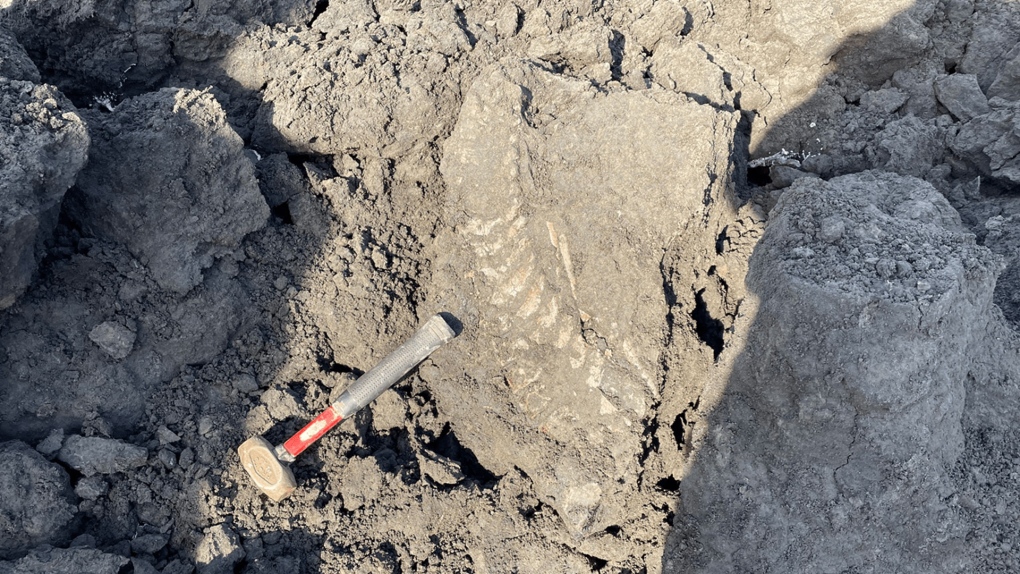Plesiosaur fossil found at Syncrude mining site in northern Alberta
 Plesiosaur fossil discovered at the Syncrude Mildred Lake Mine. (Source: Suncor.com)
Plesiosaur fossil discovered at the Syncrude Mildred Lake Mine. (Source: Suncor.com)
The oldest Cretaceous plesiosaur fossil ever found in Alberta has been discovered at Syncrude's Mildred Lake Mine site, the company says.
The discovery was made on March 12 by a hydraulic shovel operator.
Jenna Plamondon, a 16-year employee, spotted a contrast in the oil sand during her shift that day.
“I kept staring at this little chunk of dirt. As a shovel operator, we're trained to see things that are out of the ordinary," Plamondon said in a written statement on the company's website.
“I called my leader and asked to have geology look and confirm. We made the decision to move the shovel just in case it was an actual fossil.”
The company's geology team reached out to the Royal Tyrrell Museum upon discovery of the fossil.
After some examination, experts determined the fossil was part of a plesiosaur tail.
Plesiosaurs, which are marine reptiles, lived about 115 million years ago.
At that time, the Mildred Lake Mine Site would have been a vast shallow sea.
Experts say similar fossils are usually found in rock layers higher up.
They believe the creature may have died in the inland sea, and washed up into the shallow water.
“This one may have been buried in a storm, which put a great deal of sand on top of the carcass all at once. This presents very unusual preservation conditions,” Dr. Donald Henderson, curator of dinosaurs at the museum wrote on Suncor's website. “It’s so rare for things to become fossils, especially big things such as marine reptiles and dinosaurs. It’s only the fact that we’re shifting so much rock here, that we’re fortunate to see this small piece of fossil.”
Experts checked the area around the original site for additional fossil fragments, and after hours of searching, a small piece of vertebrae was found by a geology co-op student.
“As we were digging, I found something similar to bone,” said Ruachwaar Gatwech, who is in his third year of geological studies at the University of British Columbia. “The senior geologist thought it would be a good experience for me and another co-op student to come to the site. It was quite an experience. It’s my first time in the mine, first time to see and find an actual fossil in the field.”
The museum transported the fossil to Drumheller using a technique similar to casting a human bone.
Experts say this ensured the protection of the fragile bone.
“I’m really excited because if the fossil ends up being displayed at the museum, I’ll get to show my one-year-old son what mom found,” Plamondon said. “Not every shovel operator gets to find one, so it’s pretty cool that I’m one of the few.”
CTVNews.ca Top Stories

BREAKING Feds giving Toronto more than $104M to host 2026 FIFA World Cup
The federal government will provide Toronto just over $104 million in funding to host the 2026 FIFA World Cup.
More than half of Canadians say freedom of speech is under threat, new poll suggests
A new poll suggests a majority of Canadians feel their right to freedom of speech is in danger.
NEW Biscuits with possible plastic pieces, metal found in ground pork: Here are the recalls for this week
Here are the latest recalls Canadians should watch out for, according to Health Canada and the Canadian Food Inspection Agency.
Parents of infant who died in wrong-way crash on Ontario's Hwy. 401 were in same vehicle
Ontario’s Special Investigations Unit has released new details about a wrong-way collision in Whitby on Monday night that claimed the lives of four people.
Tiger Woods gets special exemption to U.S. Open at Pinehurst
Tiger Woods accepted a special exemption for the U.S. Open at Pinehurst No. 2, the first time the three-time champion has needed an exemption to play.
Britney Spears 'home and safe' after paramedics responded to an incident at the Chateau Marmont, source tells CNN
A source close to singer Britney Spears tells CNN that the pop star is 'home and safe' after she had a 'major fight' with her boyfriend on Wednesday night at the Chateau Marmont in West Hollywood.
Wally, the emotional support alligator once denied entry to a baseball game, is missing
Emotional support animal registrations in the United States reached 115,832 last year, by an industry group’s count. But in the eyes of reptile rescuer Joie Henney, there’s only one: 'Wally Gator.'
'Bare-adise' adventure: This nude cruise is due to set sail from Miami in 2025
What do you need to pack for a cruise? When it comes to this upcoming cruise from tour and travel company Bare Necessities, the answer appears to be very little.
Drew Barrymore explains how she accidentally left a list of her romantic partners at Danny DeVito's house
Danny DeVito had the opportunity to know way more about Drew Barrymore than the rest of us.





























